牛津初中英语教学设计AUnitReingThestoryofXiWg优选稿
牛津初中英语教学设计AUnitReadingThestoryofXiWang
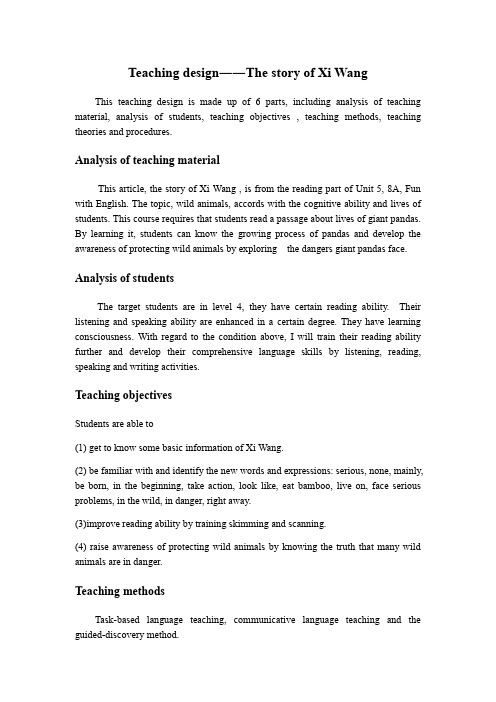
Teaching design――The story of Xi WangThis teaching design is made up of 6 parts, including analysis of teaching material, analysis of students, teaching objectives , teaching methods, teaching theories and procedures.Analysis of teaching materialThis article, the story of Xi Wang , is from the reading part of Unit 5, 8A, Fun with English. The topic, wild animals, accords with the cognitive ability and lives of students. This course requires that students read a passage about lives of giant pandas. By learning it, students can know the growing process of pandas and develop the awareness of protecting wild animals by exploring the dangers giant pandas face.Analysis of studentsThe target students are in level 4, they have certain reading ability. Their listening and speaking ability are enhanced in a certain degree. They have learning consciousness. With regard to the condition above, I will train their reading ability further and develop their comprehensive language skills by listening, reading, speaking and writing activities.Teaching objectivesStudents are able to(1) get to know some basic information of Xi Wang.(2) be familiar with and identify the new words and expressions: serious, none, mainly, be born, in the beginning, take action, look like, eat bamboo, live on, face serious problems, in the wild, in danger, right away.(3)improve reading ability by training skimming and scanning.(4) raise awareness of protecting wild animals by knowing the truth that many wild animals are in danger.Teaching methodsTask-based language teaching, communicative language teaching and the guided-discovery method.Teaching theories(1)Make students the real masters of the class and I act as a facilitator.(2)From easy to difficult, from shallow to deep, from simple to complicated. Teaching proceduresIt includes 4 steps: lead-in, pre-reading, while-reading, post-reading.Step 1 Lead-in (have a guess)Firstly, I will present students 3 sentences, they are the description of 3 animals. Then let students guess what animals they are.Secondly, ask students “What’s your favourite animals Why” I will ask some students to share their favourite animals with us.(Purpose: To lead in the topic and to arouse students’ interest by a guessing game)Step 2 Pre-readingActivity 1: important words and expressions learning1.In step1, students have shared their favourite animals, so I will ask them: “Do you know what’s my favourite animals” to arouse their interest. Then HaI will also give them a descriptive sentence to guess what it is――gaint panda.2.Show students a short paragraph of the reason why I like them and some basic information of gaint pandas. (These sentences contain important words and expressions)3.Have students finish B1 to consolidate the words and expressions.(Purpose: To deal with the difficult language points which may impede the understanding and to have students be prepared for the reading.)Activity 2: PredictingI’ll ask students “Can you predict the content of the article according to the title---The story of Xi Wang” In this process, I’ll encourage students to think and speak out freely. (Purpose: To enable students to predict before reading and train the strategy of predicting)Step 3 While-readingListeningI will have students listen the article before reading. Before listening, I will ask them a question “How many pandas are there in the wild”. Have them answer after listening. (To train their ability of listening with questions)Fast-reading (matching)I have divided the article into 4 parts and present the main idea of each part randomly.Have students read the article quickly and do the matching.( To improve ability of skimming)Careful-reading1.Fill-in-table activity. Have students read para1-3, discuss with partners to fill in the table.2.Have students read para4 to find the serious problems giant pandas face.3. Discussion:group workGive students a question “What can we do to protect wild animals” Have them discuss in groups to put forward suggestions.(Purpose: To improve ability of scanning and to enhance their awareness of cooperation in pair and group work)Step 4 Post-reading1.Review: ask one students to lead the whole class to review what they have learned in this lesson.2.World Wildlife Protection DayHomework: have students surf in the internet to look for information of World Wildlife Protection Day. In the next lesson, share the information with the whole class.(Purpose: To train their ability of looking for information and have them aware the importance of wildlife protection in the process of surfing the Internet)。
【牛津上海版】七年级英语下Unit 1-11 全套单元教学设计
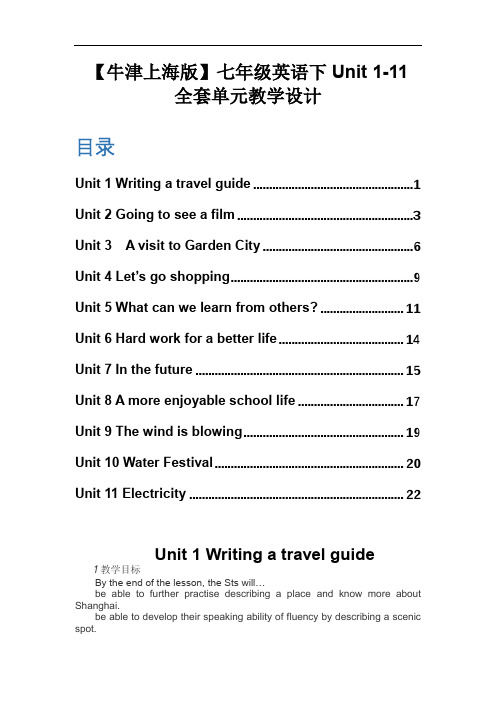
【牛津上海版】七年级英语下Unit 1-11全套单元教学设计目录Unit 1 Writing a travel guide (1)Unit 2 Going to see a film (3)Unit 3 A visit to Garden City (6)Unit 4 Let’s go shopping (9)Unit 5 What can we learn from others? (11)Unit 6 Hard work for a better life (14)Unit 7 In the future (15)Unit 8 A more enjoyable school life (17)Unit 9 The wind is blowing (19)Unit 10 Water Festival (20)Unit 11 Electricity (22)Unit 1 Writing a travel guide 1教学目标By the end of the lesson, the Sts will…be able to further practise describing a place and know more about Shanghai.be able to develop their speaking ability of fluency by describing a scenic spot.2学情分析The learners are the students form Class Twelve, Grade Seven of North Jincai Secondary School. They have been learning English for 7 years, so they are of different levels. Quite a few students are quite excellent. They do well in both speaking and writing. They are very active in class. But some students are at a lower English level. However, sometimes they can speak a little in class. What they need is a language environment. Therefore, group work in class is helpful for them to take an active part in the class.3重点难点This is ‘more practice’ part of Module One. The to pic is A One-day Tour Plan. We have talked about some famous places in the previous period, so the students have learned some expressions. There will be a language environment created for them so as to encourage more of them to talk about scenic spots and their tour plans.Key phrases and sentence structures are familiar to students. But it will be a little hard for them to organize language with much new information. So teacher can take fully advantage of group work. The students may have difficulty in listening to the French in the second part because of the accent. Teachers can give students a second chance to listen.Some students may also have difficulty in pronouncing some words. Teachers can guide them to use the dictionaries on their Pads.4教学过程第一学时教学目标By the end of the lesson, the Sts will…be able to further practise describing a place and know more about Shanghai.be able to develop their speaking ability of fluency by describing a scenic spot.学时重点This is ‘more practice’ part of Module One. Th e topic is A One-day Tour Plan. We have talked about some famous places in the previous period, so the students have learned some expressions. There will be a language environment created for them so as to encourage more of them to talk about scenic spots and their tour plans.学时难点Key phrases and sentence structures are familiar to students. But it will be a little hard for them to organize language with much new information. So teacher can take fully advantage of group work. The students may have difficulty in listening to the French in the second part because of the accent. Teachers can give students a second chance to listen.Some students may also have difficulty in pronouncing some words. Teachers can guide them to use the dictionaries on their Pads.教学活动活动1【导入】Lead inIt’s said that they really enjoyed the trip to Shanghai. Do you want to k now where they have been? I will show you some pictures of places they’ve been. Please take notes when you are watching.T gives the following instructions:1. I will show you some pictures of places they’ve been.2. Please take notes when you are watching.3. After that, please tell me how many places are there altogether and what they are.T shows four pictures of some places.S answers according to the picture.T corrects the mistakes and may show the pictures again if necessary.(Pudong International Airport, the bund, Yu garden, Shanghai zoo, Xintiandi, Shanghai Science and Technology Museum and Shanghai Museum) 活动2【活动】Input-listeningT: Among these pictures, do you know their favourite place?Students may give some answers or no answer.T: I’ve invited 4 French students to talk about their favourite places. Let’s listen to them. Please take notes while listening.T plays the recording one by one.T invites students to give answers and give reasons.T giv es feedback if the students’ answers are wrong.活动3【活动】Input-readingT: French students told me that they wanted to know more about Shanghai, about those they have been to, and also about those they haven’t. Would you please give them some introductions about more places? First, you need to read some instructions.T gives the instructions.1. Work in a group of 6.2. Each group needs to read 8 passages and find useful information as much as possible.3. Take notes and finish the table.4. Group A is responsible for sightseeing, Group B shopping and Group C eating.T provides individual drilling.活动4【活动】Output-an introduction about a scenic spotT invites some students to introduce some scenic spots according to the information they have taken down.T gives feedbacks about their presentations.活动5【活动】Output-a tour planT: I think they will enjoy those places. So why not make a tour plan for them? Please discuss with your group members and make a one-day tour plan for them. Each group needs to focus on your task. (Group A sightseeing Group B eating Group C shopping.)T provides individual drilling.T invites some students to give presentations about their tour plans.T gives feedbacks about their presentations.活动6【作业】AssignmentT: Write down your 3-day tour plan for French students. The school may use your plan next year.e.g.: On the first day, they are going to …Unit 2 Going to see a film1教学目标认知目标:课标词汇hardly, type, operate, railway, fly, judge, raise, instruction, program, mistake, hold, video, more importantly, have great understanding of…, make mistakes, for the time being拓展词汇unaware, be unaware of…, dependent, be dependent on…,diagram,essential, drive, CD-ROM, DVD-ROM2. 能力发展目标:1)通过多种形式的阅读活动与任务,培养一些阅读微技能,如:整体把握文章大意,快速搜索信息的能力2)设计小组合作,学会交流与合作3)情感目标:拓展学生视野,培养学生正确表达自己观点,学会对电影做出评价2学情分析1.这是一篇影评,比较枯燥,学生容易失去兴趣。
牛津深圳版英语九年级上册:Unit8《Surpriseendings》说课稿3

牛津深圳版英语九年级上册:Unit 8 《Surprise endings》说课稿3一. 教材分析《Surprise endings》是人教版牛津深圳版英语九年级上册第8单元的内容。
本节课的主要内容是讲述一个关于意外结局的故事,通过故事让学生学习并掌握一些日常英语表达和语法知识。
教材内容丰富,插图生动有趣,激发了学生的学习兴趣。
同时,教材还设置了各种练习题,帮助学生巩固所学知识。
二. 学情分析九年级的学生已经具备了一定的英语基础,能够听、说、读、写一些简单的英语句子。
但是,对于一些复杂的语法知识和词汇表达,学生可能还不是很熟悉。
因此,在教学过程中,教师需要关注学生的个体差异,因材施教,尽量让每个学生都能参与到课堂活动中来。
三. 说教学目标1.知识目标:学生能够掌握故事情节,理解并运用本节课所学的日常英语表达和语法知识。
2.能力目标:学生能够流利地朗读故事,并进行角色扮演。
3.情感目标:学生能够通过故事,学会珍惜友谊,懂得友谊的力量。
四. 说教学重难点1.教学重点:学生能够听懂、说出一篇关于意外结局的短文。
2.教学难点:学生能够正确运用本节课所学的日常英语表达和语法知识,进行情景对话。
五. 说教学方法与手段本节课采用情境教学法、交际教学法和任务型教学法。
教师会通过多媒体课件、图片、情景剧等形式,创设各种真实的语言环境,让学生在实践中学习、运用英语。
同时,教师还会学生进行小组合作学习,培养学生的团队精神和自主学习能力。
六. 说教学过程1.导入:教师通过播放一个有趣的短视频,引导学生谈论关于意外结局的话题,激发学生的学习兴趣。
2.呈现:教师通过课件展示故事情节,引导学生关注故事中的意外结局,让学生初步感知本节课的主要内容。
3.操练:教师学生进行小组活动,让学生用英语讲述自己知道的故事,培养学生的口头表达能力。
4.讲解:教师讲解本节课所学的日常英语表达和语法知识,让学生进行课堂练习。
5.巩固:教师设置各种练习题,让学生进行课堂巩固。
牛津深圳初中英语九上Unit 8《Surprise endings》教案1

1.Let students get familiar with the new words
2.Getthe ss master the usages of the key words
3.make the ss preview the story about the O’Henry.
4. Train the students’ability to cooperate.Let the students in different levels can take part in the activity.
5. Providethe chances for students to show themselves and practice the speaking ability.
3. help the students when they have trouble inreading the new words
4.Show the PPT of the meaning of the key wordsand givesome exercise for them to dogift/graduation/cent /count/afford/ present/knee/ sign/ search/ chain/ bill/ step// draw/ set/
7. Todevelop the students’ability of self–checking.
5
第五环节 课后作业
Preview the text and finish the exercise before
and afterthe text.
Discussto tell theChinesemeaning of the text and underlined the new words in the text
牛津版初中英语八年级上册 U1- Writing
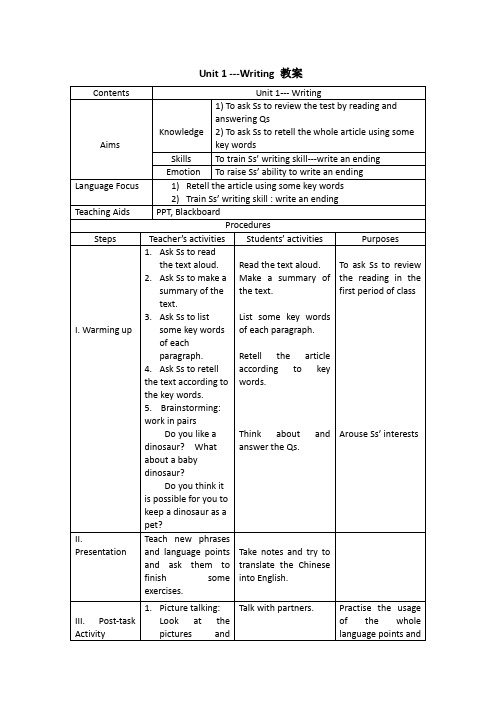
1.Picture talking:
Look at the pictures andanswer the following questions:
What can you see in the picture?
What was the boy doing?
What would the boy do?
List some key words of each paragraph.
Retell the article according to key words.
Think about and answer the Qs.
To ask Ss to review the reading in the first period of class
Skills
To train Ss’ writing skill---write an ending
Emotion
To raise Ss’ ability to write an ending
Language Focus
1)Retell the article using some key words
2)Train Ss’ writing skill : write an ending
Teaching Aids
PPT, Blackboard
Procedures
Steps
Teacher’s activities
Students’ activities
Purposes
. Warming up
1.Ask Ss to read the text aloud.
Arouse Ss’ห้องสมุดไป่ตู้interests
牛津上海版九年级下册 Unit 5 A story by MarkTwain教学设计
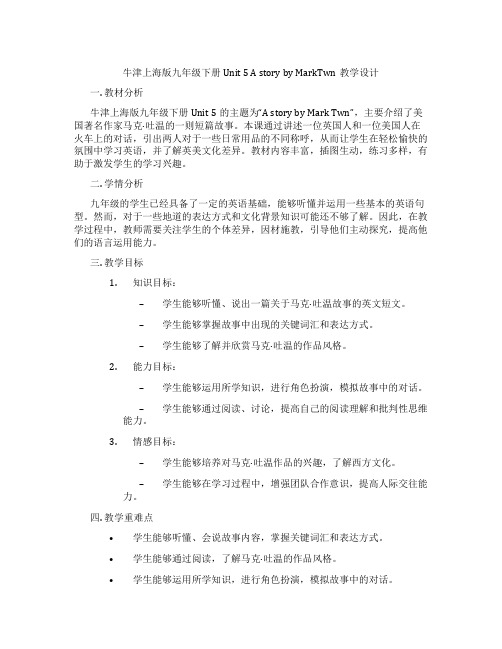
牛津上海版九年级下册 Unit 5 A story by MarkTwn教学设计一. 教材分析牛津上海版九年级下册Unit 5的主题为“A story by Mark Twn”,主要介绍了美国著名作家马克·吐温的一则短篇故事。
本课通过讲述一位英国人和一位美国人在火车上的对话,引出两人对于一些日常用品的不同称呼,从而让学生在轻松愉快的氛围中学习英语,并了解英美文化差异。
教材内容丰富,插图生动,练习多样,有助于激发学生的学习兴趣。
二. 学情分析九年级的学生已经具备了一定的英语基础,能够听懂并运用一些基本的英语句型。
然而,对于一些地道的表达方式和文化背景知识可能还不够了解。
因此,在教学过程中,教师需要关注学生的个体差异,因材施教,引导他们主动探究,提高他们的语言运用能力。
三. 教学目标1.知识目标:–学生能够听懂、说出一篇关于马克·吐温故事的英文短文。
–学生能够掌握故事中出现的关键词汇和表达方式。
–学生能够了解并欣赏马克·吐温的作品风格。
2.能力目标:–学生能够运用所学知识,进行角色扮演,模拟故事中的对话。
–学生能够通过阅读、讨论,提高自己的阅读理解和批判性思维能力。
3.情感目标:–学生能够培养对马克·吐温作品的兴趣,了解西方文化。
–学生能够在学习过程中,增强团队合作意识,提高人际交往能力。
四. 教学重难点•学生能够听懂、会说故事内容,掌握关键词汇和表达方式。
•学生能够通过阅读,了解马克·吐温的作品风格。
•学生能够运用所学知识,进行角色扮演,模拟故事中的对话。
•学生能够通过阅读、讨论,提高自己的阅读理解和批判性思维能力。
五. 教学方法1.情境教学法:通过设置情境,让学生在真实的语言环境中学习英语,提高他们的语言运用能力。
2.交际法:通过角色扮演、小组讨论等活动,让学生在交流中学习,提高他们的口语表达能力和团队协作能力。
3.任务型教学法:通过完成各种任务,让学生在实践中学习,提高他们的综合语言运用能力。
牛津初中英语阅读教学设计
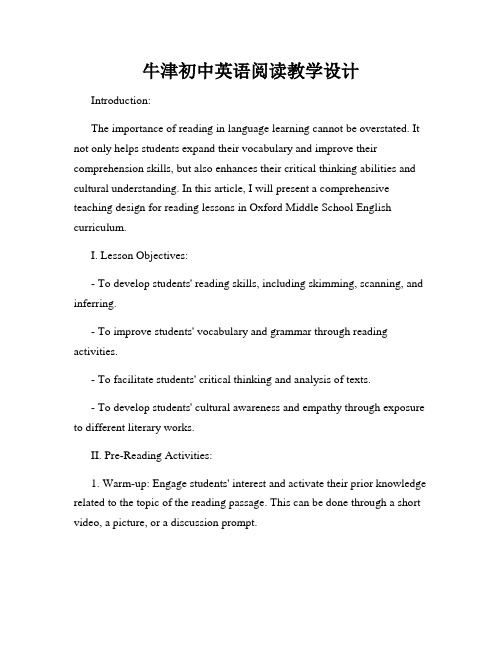
牛津初中英语阅读教学设计Introduction:The importance of reading in language learning cannot be overstated. It not only helps students expand their vocabulary and improve their comprehension skills, but also enhances their critical thinking abilities and cultural understanding. In this article, I will present a comprehensive teaching design for reading lessons in Oxford Middle School English curriculum.I. Lesson Objectives:- To develop students' reading skills, including skimming, scanning, and inferring.- To improve students' vocabulary and grammar through reading activities.- To facilitate students' critical thinking and analysis of texts.- To develop students' cultural awareness and empathy through exposure to different literary works.II. Pre-Reading Activities:1. Warm-up: Engage students' interest and activate their prior knowledge related to the topic of the reading passage. This can be done through a short video, a picture, or a discussion prompt.2. Vocabulary Preview: Introduce key vocabulary words from the reading passage to ensure students understand the main ideas and are equipped with the necessary language tools.3. Prediction: Encourage students to make predictions about the content of the passage based on the title, headings, or pictures. This stimulates their curiosity and prepares them for a purposeful reading experience.III. While-Reading Activities:1. Skimming: Instruct students to quickly read through the passage to geta general idea of the main topic and the overall structure. They should focus on identifying the main idea of each paragraph and any supporting details.2. Scan for Specific Information: Assign students specific questions or tasks that require them to locate specific details, such as dates, names, or specific facts. This activity helps improve their scanning skills and attention to detail.3. Comprehension Questions: Prepare a set of comprehension questions that help students understand the main ideas, infer meaning, and analyze the author's purpose. Allow students to work individually or in pairs to discuss and answer the questions.4. Vocabulary Expansion: Identify challenging vocabulary words within the passage and provide explanations, synonyms, or contextual examples to deepen students' understanding. Encourage them to create sentences using the new vocabulary words.IV. Post-Reading Activities:1. Discussion: Initiate a group or class discussion to allow students to share their thoughts and opinions about the reading passage. Encourage them to express their understanding, reflect on the content, and connect it to their own experiences or other texts.2. Writing Tasks: Assign writing tasks that require students to summarize the main ideas, analyze the text, or express their personal opinions. This helps reinforce their reading comprehension, writing skills, and critical thinking abilities.3. Extension Activities: Provide additional resources, such as related articles, videos, or online platforms, to encourage further exploration of the topic. This allows students to delve deeper into the subject matter and broaden their understanding.Conclusion:A well-designed reading lesson not only enhances students' reading skills but also promotes their language proficiency, critical thinking, and cultural awareness. By following this comprehensive teaching design for reading lessons in Oxford Middle School English curriculum, teachers can ensure an engaging and effective learning experience for their students.。
牛津初中英语教学设计ReingThestoryofXiWang

牛津初中英语教学设计R e i n g T h e s t o r y o f X i Wa n g文件管理序列号:[K8UY-K9IO69-O6M243-OL889-F88688]Teaching design――The story of Xi WangThis teaching design is made up of 6 parts, including analysis of teaching material, analysis of students, teaching objectives , teaching methods, teaching theories and procedures. Analysis of teaching materialThis article, the story of Xi Wang , is from the reading part of Unit 5, 8A, Fun with English. The topic, wild animals, accords with the cognitive ability and lives of students. This course requires that students read a passage about lives of giant pandas. By learning it, students can know the growing process of pandas and develop the awareness of protecting wild animals by exploring the dangers giant pandas face.Analysis of studentsThe target students are in level 4, they have certain reading ability. Their listening and speaking ability are enhanced in a certain degree. They have learning consciousness. With regard to the condition above, I will train their reading ability further and develop their comprehensive language skills by listening, reading, speaking and writing activities.Teaching objectivesStudents are able to(1) get to know some basic information of Xi Wang.(2) be familiar with and identify the new words and expressions: serious, none, mainly, be born, in the beginning, take action, look like, eat bamboo, live on, face serious problems, in the wild, in danger, right away.(3)improve reading ability by training skimming and scanning.(4) raise awareness of protecting wild animals by knowing the truth that many wild animals are in danger.Teaching methodsTask-based language teaching, communicative languageteaching and the guided-discovery method.Teaching theories(1)Make students the real masters of the class and I act as a facilitator.(2)From easy to difficult, from shallow to deep, from simple to complicated.Teaching proceduresIt includes 4 steps: lead-in, pre-reading, while-reading, post-reading.Step 1 Lead-in (have a guess)Firstly, I will present students 3 sentences, they are the description of 3 animals. Then let students guess what animals they are.Secondly, ask students “What’s your favourite animals Why” I will ask some students to share their favourite animals with us. (Purpose: To lead in the topic and to arouse students’interest by a guessing game)Step 2 Pre-readingActivity 1: important words and expressions learning1.In step1, students have shared their favourite animals, so I will ask them: “Do you know what’s my favourite animals” to arouse their interest. Then HaI will also give them adescriptive sentence to guess what it is――gaint panda.2.Show students a short paragraph of the reason why I like them and some basic information of gaint pandas. (These sentences contain important words and expressions)3.Have students finish B1 to consolidate the words and expressions.(Purpose: To deal with the difficult language points which may impede the understanding and to have students be prepared forthe reading.)Activity 2: PredictingI’ll ask students “Can you predict the content of the article according to the title---The story of Xi Wang” In this process, I’ll encourage students to think and speak out freely.(Purpose: To enable students to predict before reading andtrain the strategy of predicting)Step 3 While-readingListeningI will have students listen the article before reading. Before listening, I will ask them a question “How many pandas are there in the wild”. Have them answer after listening. (To train their ability of listening with questions)Fast-reading (matching)I have divided the article into 4 parts and present the main idea of each part randomly.Have students read the article quickly and do the matching. ( To improve ability of skimming)Careful-reading1.Fill-in-table activity. Have students read para1-3, discuss with partners to fill in the table.2.Have students read para4 to find the serious problems giant pandas face.3. Discussion:group workGive students a question “What can we do to protect wild animals” Have them discuss in groups to put forward suggestions.(Purpose: To improve ability of scanning and to enhance their awareness of cooperation in pair and group work)Step 4 Post-reading1.Review: ask one students to lead the whole class to review what they have learned in this lesson.2.World Wildlife Protection DayHomework: have students surf in the internet to look for information of World Wildlife Protection Day. In the next lesson, share the information with the whole class.(Purpose: To train their ability of looking for information and have them aware the importance of wildlife protection in the process of surfing the Internet)。
- 1、下载文档前请自行甄别文档内容的完整性,平台不提供额外的编辑、内容补充、找答案等附加服务。
- 2、"仅部分预览"的文档,不可在线预览部分如存在完整性等问题,可反馈申请退款(可完整预览的文档不适用该条件!)。
- 3、如文档侵犯您的权益,请联系客服反馈,我们会尽快为您处理(人工客服工作时间:9:00-18:30)。
牛津初中英语教学设计A U n i t R e i n g T h e s t o r yo f X i W g集团公司文件内部编码:(TTT-UUTT-MMYB-URTTY-ITTLTY-Teaching design――The story of Xi WangThis teaching design is made up of 6 parts, including analysis of teaching material, analysis of students, teaching objectives , teaching methods, teaching theories and procedures. Analysis of teaching materialThis article, the story of Xi Wang , is from the reading part of Unit 5, 8A, Fun with English. The topic, wild animals, accords with the cognitive ability and lives of students. This course requires that students read a passage about lives of giant pandas. By learning it, students can know the growing process of pandas and develop the awareness of protecting wild animals by exploring the dangers giant pandas face.Analysis of studentsThe target students are in level 4, they have certain reading ability. Their listening and speaking ability are enhanced in a certain degree. They have learning consciousness. With regard to the condition above, I will train their reading ability further and develop their comprehensive language skills by listening, reading, speaking and writing activities.Teaching objectivesStudents are able to(1) get to know some basic information of Xi Wang.(2) be familiar with and identify the new words and expressions: serious, none, mainly, be born, in the beginning, take action, look like, eat bamboo, live on, face serious problems, in the wild, in danger, right away.(3)improve reading ability by training skimming and scanning.(4) raise awareness of protecting wild animals by knowing the truth that many wild animals are in danger.Teaching methodsTask-based language teaching, communicative languageteaching and the guided-discovery method.Teaching theories(1)Make students the real masters of the class and I act as a facilitator.(2)From easy to difficult, from shallow to deep, from simple to complicated.Teaching proceduresIt includes 4 steps: lead-in, pre-reading, while-reading, post-reading.Step 1 Lead-in (have a guess)Firstly, I will present students 3 sentences, they are the description of 3 animals. Then let students guess what animals they are.Secondly, ask students “What’s your favourite animals Why” I will ask some students to share their favourite animals with us. (Purpose: To lead in the topic and to arouse students’interest by a guessing game)Step 2 Pre-readingActivity 1: important words and expressions learning1.In step1, students have shared their favourite animals, so I will ask them: “Do you know what’s my favourite animals” to arouse their interest. Then HaI will also give them adescriptive sentence to guess what it is――gaint panda.2.Show students a short paragraph of the reason why I like them and some basic information of gaint pandas. (These sentences contain important words and expressions)3.Have students finish B1 to consolidate the words and expressions.(Purpose: To deal with the difficult language points which may impede the understanding and to have students be prepared forthe reading.)Activity 2: PredictingI’ll ask students “Can you predict the content of the article according to the title---The story of Xi Wang?” Inthis process, I’ll encourage students to think and speak outfreely. (Purpose: To enable students to predict before reading and train the strategy of predicting)Step 3 While-readingListeningI will have students listen the article before reading. Before listening, I will ask them a question “How many pandas are there in the wild?”. Have them answer after listening. (To train their ability of listening with questions)Fast-reading (matching)I have divided the article into 4 parts and present the main idea of each part randomly.Have students read the article quickly and do the matching. ( To improve ability of skimming)Careful-reading1.Fill-in-table activity. Have students read para1-3, discuss with partners to fill in the table.2.Have students read para4 to find the serious problems giant pandas face.3. Discussion:group workGive students a question “What can we do to protect wild animals?” Have them discuss in groups to put forward suggestions.(Purpose: To improve ability of scanning and to enhance their awareness of cooperation in pair and group work)Step 4 Post-reading1.Review: ask one students to lead the whole class to review what they have learned in this lesson.2.World Wildlife Protection DayHomework: have students surf in the internet to look for information of World Wildlife Protection Day. In the next lesson, share the information with the whole class.(Purpose: To train their ability of looking for information and have them aware the importance of wildlife protection in the process of surfing the Internet)。
